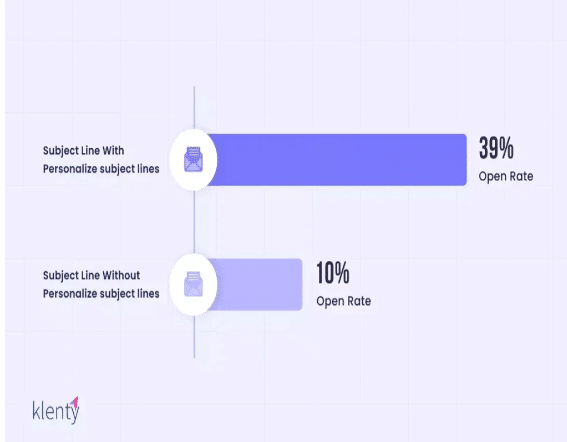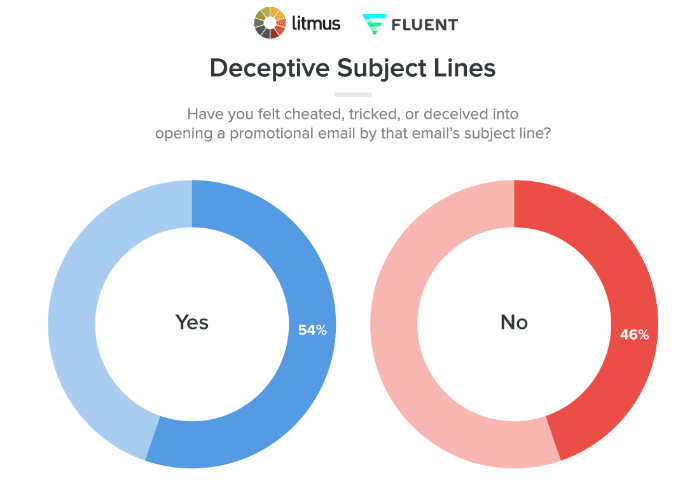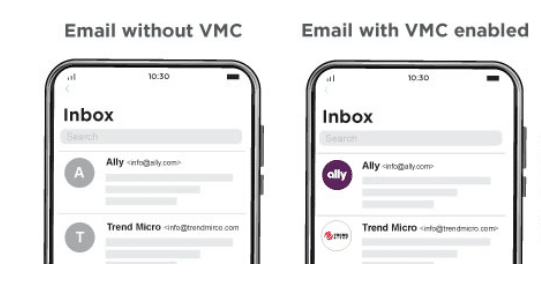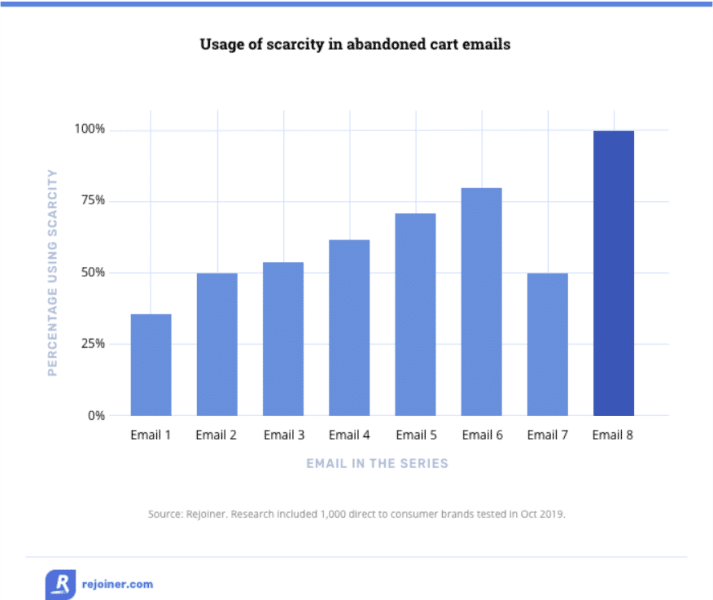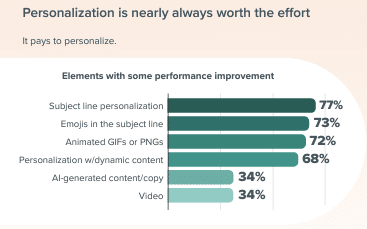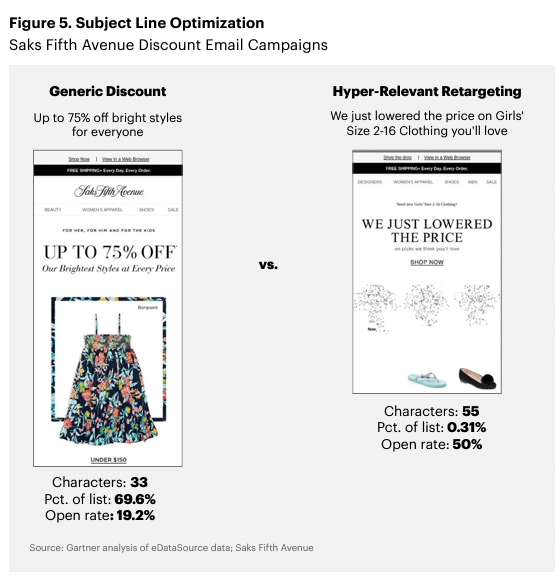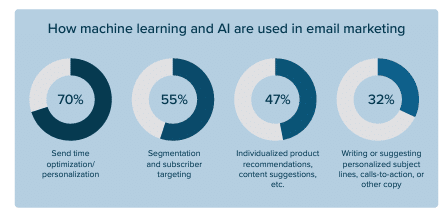Overflowing email inboxes mean the battle is won or lost at the subject line. For marketers and business owners, the ability to craft catchy email subject lines is vital, not just valuable.
The trends in what makes a good email subject line continue to evolve.
By writing email subject lines that incorporate power words, are optimized for mobile devices, and evoke an emotional and psychological response, your emails stand a better chance at capturing attention.
Improve your email strategy with insights from experts at Business2Community.
Email Subject Line Best Practices – Key Data
- Email subject lines with a recipient’s name increase average open rates to 39%; those without result in a lower open rate of just 10%.
- Subject lines without emojis have a higher open rate at 52.94%, compared to 47.06% for those with emojis.
- Longer personalized subject lines achieve a higher open rate (31%) than shorter subject lines (20%).
- Adding a registered logo with a Verified Mark Certificate (VMC) to your email subject lines boosts open rates by 21%.
- Segmented email campaigns achieve 30% more opens and 50% more clickthroughs compared to non-segmented ones.
What Makes a Successful Email Subject Line?
Several factors contribute to a subject line’s success, from personalization to the use of emojis, and understanding these can significantly impact your email marketing campaign’s open and click-through rates. Here is data to demonstrate email subject line best practices you can implement.
Personalization
Personalization has proven time and again to be a game-changer in email marketing.
Including the recipient’s name or other personal information can make an email subject line feel more tailored and less like a mass message, signaling that the email contains content specifically relevant to them.
A study completed by Klenty in 2024 showed that when the subject line includes a recipient’s name, the average open rate increased to 39%.
In contrast, emails without the recipient’s name – even if they have other personal touches – have a much lower open rate of just 10%.
People get curious when they see their names in unexpected places, like a cold email in their inbox, making them more likely to open it.
Selective Use of Emojis
The strategic use of emojis in email subject lines can make an email stand out in an overcrowded inbox.
They add a touch of personality and can convey emotions or summarize the email’s content in a fun and engaging way. However, it’s crucial to use emojis that are relevant to the message and resonate with your target audience.
In an analysis completed by Search Engine Journal in 2020, the comparison of wins for emoji versus non-emoji returned the answer that email subject lines without an emoji had the higher open rate at 52.94% to 47.06%.
Despite some marginal differences, this trend was consistent across various campaigns.
Surprisingly, emails with emojis in the subject line showed a higher click-through rate (64.71%). This unexpected result suggests that, even if open rates are slightly lower, emojis might enhance engagement among those who do open the emails.
The analysis also revealed a higher unsubscribe rate (70.59%) for emails with emojis, indicating a potential negative sentiment associated with the use of emojis in email subject lines. Emails with emojis also generated more abuse complaints, with 7 out of 10 campaigns receiving higher complaint rates than non-emoji campaigns.
Mailchimp and recommended using no more than one emoji per email subject line. Emojis should be used as complementary elements to words rather than substitutions to ensure the effective delivery of your main message.
As part of email subject line best practices, it is important as various operating systems may display different versions of emojis.
Capitalization and Punctuation
Proper use of capitalization and punctuation can either make or break your subject line.
While ALL CAPS can grab attention, overuse may be perceived as shouting and could turn recipients off. On the contrary, capitalizing the first letter of each word can enhance readability without seeming aggressive.
Question marks and exclamations can engage curiosity and excitement, respectively, but should be used sparingly to avoid looking spammy. Mailchimp’s research suggests limiting the use of punctuation marks to no more than three instances per subject line.
Use of “Fw” and “Re”
Using “Fw” (forward) and “Re” (reply) in email subject lines can create a sense of continuity and urgency, suggesting to the recipient that the email is part of an ongoing conversation (and not just a random email from a company).
33While this might initially seem like a clever strategy to boost open rates, it’s considered a gimmicky subject line and could also trigger spam filters.
Misusing these prefixes can lead to a breach of trust between the sender and recipient, as it may be perceived as misleading or as an attempt to manipulate the recipient into opening the email, which is definitely not part of email subject line best practices! As with emojis, it’s crucial to use these prefixes only when appropriate and avoid overusing them.
Sender Details
It’s not only about writing subject lines – the impact of familiar sender details on open rates cannot be underestimated.
Having an identifiable sender name rather than a generic email address can significantly enhance the chances of an email being opened.
Including the sender’s name or the company’s name adds a layer of personalization and trustworthiness.
A 2021 survey by Red Sift and Entrust revealed that adding a registered logo with a Verified Mark Certificate (VMC) boosted open rates by 21%.
Clarity and Conciseness
Clarity and conciseness when writing email subject lines directly influence the recipient’s decision to open the email. A subject line that clearly and succinctly communicates the email’s value proposition or primary message is more likely to capture interest.
Avoiding overly complex or vague language ensures the message is accessible at a glance, which is especially important in today’s fast-paced digital environment. Achieve your communication goals with strategic subject lines tailored to your needs – opt for concise and clear lines for broad outreach, or delve into detailed specificity for targeted engagement with niche audience subsets.
Urgency
You can create urgency with good email subject lines that can significantly enhance open rates by tapping into the reader’s fear of missing out (FOMO). A great subject line that suggests a limited-time offer or exclusive opportunity compels recipients to act quickly to avoid losing out and achieve the desired outcome of opening your email message.
Important: Use this tactic authentically to avoid diminishing trust.
Rejoiner’s research from 2019 analyzing abandoned cart emails found that 44% of the emails used scarcity or urgency to drive conversions, while humor was less reliable.
This effect was most pronounced when the subject line included discounts, with 31% of the emails including an offer.
Personalization in Your Email Subject Lines
Personalization in email subject lines moves beyond merely inserting a recipient’s name.
It involves tailoring the message to reflect the recipient’s history, preferences, and behavior. While incorporating a name is a good start, this is starting to become the bare minimum and effective personalization digs deeper.
In the 2024 State of Email Trends Report by Litmus, over 80% of participants noted performance enhancements with subject line personalization, real-time content, and dynamic content personalization.
Brands that use longer subject lines have more success with open rates since those subject lines tend to be tailored to specific audiences. According to Gartner’s Digital IQ: Email Benchmarks 2021 report, industries like financial services use subject lines that are over 55 characters long and still get a high open rate of 31%.
For comparison, consumer goods brands average subject lines of 40 characters maximum and see 20% open rates.
In email marketing, machines and AI are employed to handle different tasks, with 32% dedicated specifically to crafting or suggesting personalized subject lines.
This finding is part of Litmus’ 2021 State of Email Report, highlighting the significance of personalized content in email campaigns.
Email Subject Lines and Spam
The boundary between an engaging email subject line and one that screams “spam folder” can often be finer than many marketers might anticipate. Identifying and avoiding spam words or phrases classified as “spammy” can be crucial in ensuring that your email reaches the inbox and, more importantly, is opened by the recipient.
Here are some common categories and examples of what might be considered spam triggers:
- Urgency overkill: “Act Now!”, “Immediate”, “Urgent”
- Too good to be true and false promises: “Congratulations!”, “You’re a Winner!”, “Get Rich Quick”
- Overuse of free: “FREE”, “Free Gift”, “Free Access Without Condition”
- Aggressive sales pitch: “Buy”, “Purchase”, “Order Now”
- Misleading phrases: “Re:”, “Fwd:”, when it’s not a reply or forward
The perception of what constitutes spam varies among consumers and email service providers, but it generally boils down to unsolicited, irrelevant, or overly aggressive communications.
Remember: When emails are marked as spam, it not only impacts deliverability rates but can also tarnish a brand’s reputation and cause problems for future email marketing campaigns.
Finding the Best Email Subject Lines Through A/B Testing
Testing is crucial in email campaigns and is one of the tried and true tips for marketing emails.
A/B testing and multivariate testing, especially for elements like subject lines, design, and content, are vital. Regularly testing and tweaking your email strategies helps find areas to improve, leading to higher authentic open and click-through rates, ultimately boosting click-to-open rates.
The potency of a perfect subject line can be enhanced by leveraging segmentation, allowing for more targeted and relevant subject lines and successful future campaigns. For instance, mentioning a specific product category in the subject line only to those customers who have shown interest in it previously.
Data consistently shows that segmented email campaigns achieve higher open rates compared to non-segmented ones.
According to a 2019 survey conducted among marketers globally, 84% of respondents reported incorporating basic segmentation in their email marketing efforts.
What Are Email Subject Line Best Practices?
The art and science of crafting compelling email subject lines to get noticed in a crowded inbox encapsulates more than just avoiding the spam filter – it’s about striking a chord with the recipient in a single line.
The essence of best practices in email subject lines can be distilled into relevance, personalization, clarity, and urgency, all balanced with a keen respect for the recipient’s expectations and privacy.
Remember, your subject line is your email’s first impression that your audience responds to, and in many cases, it could be your only chance to engage with them. That’s why it’s critical to invest in A/B testing to decipher what resonates best with your demographics. Simultaneously, incorporating segmentation from the get-go tailors your approach, ensuring that your message is as relevant and appealing as possible to each recipient.
Ultimately, an effective email subject line serves as a gateway to deeper engagement, fostering a relationship between the brand and the recipient.
It’s not just about getting an opening, it’s about initiating a dialogue and nurturing a personal connection.
By adhering to these best practices, email marketers can significantly improve their open rates, build trust, and drive meaningful interactions with their audience.
Always aim to craft email subject lines that are a welcome in the inbox, not just another message vying for attention.

